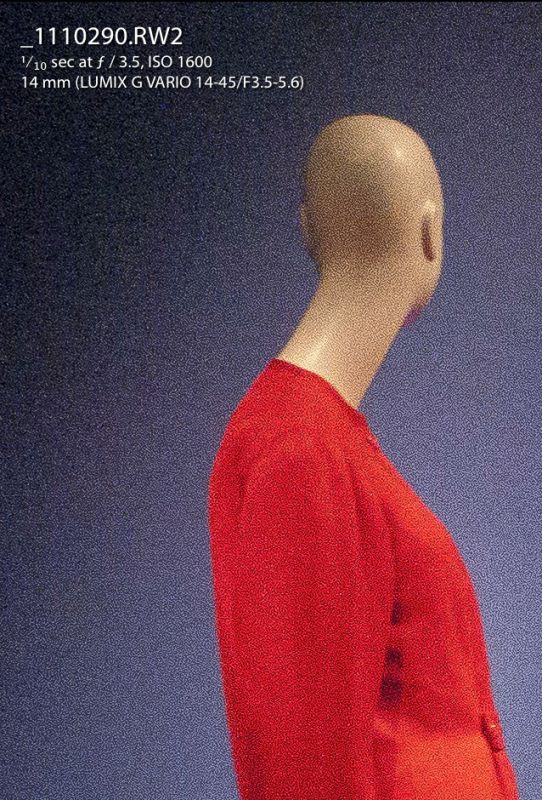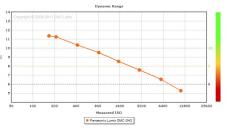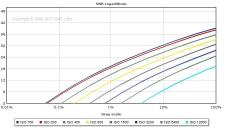
Please, support PV!
It allows to keep PV going, with more focus towards AI, but keeping be one of the few truly independent places.
It allows to keep PV going, with more focus towards AI, but keeping be one of the few truly independent places.
AVCHD maximum image quality settings and testing
-
@stonebat
"Saturation 0 or -1 might have reduced some color noise."
Perhaps, but my personal aesthetic is for rich, detailed colors. -
@Stray - "Edit : I figure the small improvement just isn't worth the dramtic increase in file size, and much shorter shot length for most of us."
I totally respect and get that.
But this is the max image and quality thread, and the honest truth is, if we could find a setting that ate up a 16gig card in 8 minutes but gave better results, that's what I'd use for b-roll with the GH2. How good can the camera possibly look and shoot reasonably reliably. I think that should be the goal of this thread. -
132 definitely has finer noise reproduction. No question about that. Some people will find it useful. But shorter recording time and possible in-camera playback issue. I'm sure some people wouldn't mind that.
We are learning more pros and cons. I like the details. Hopefully the same testing can be done when we get new PTool as VK and Chris are working on improving the codec. -
Yep, cool, I get that, you're right. I must admit I was playing a lot with the 132M AQ2 GOP 3 yesterday and was completely gobsmacked by it's stability more than anything. I actually don't like the look of motion with GOP 3, but as said I would expect a lower GOP to dramatically improve noise rendering (and therefore NR in post). I don't think I'll ever use it.. but I know its there, if I ever have to do that one shot where I know I'll have to do a lot of work in a deep shadow area. Say, if I wanted to do a VFX shot where I'll have a CG element travelling from deep shadow to light or somesuch. But it's not something I'll reach for everyday.
-
@Ralph_B
I like rich color, too. But sometimes lighting condition makes some color to clip. The streetlight might have clipped green color on the trees.
No this is not a complaint. I appreciate your testing. -
Also, be aware if you can see more finer noise, this means you are able to see more fine detail which results in a better detailed image.
-
"Also, be aware if you can see more finer noise, this means you are able to see more fine detail which results in a better detailed image."
+1
And let's not forget, the GH2's ability to resolve fine detail is one of the things that sets it apart from every other DSLR on the market. This is it's strength. So it makes sense to maximize it. cosimo_bullo is using it in conjunction with Red 4K. That speaks volumes. -
So what we want is nose reproduction closer to the one from RAW photo?
http://pindelski.org/Photography/2011/04/20/small-sensor-noise/
-
@stonebat, I think so, yes. Finer, more detailed grain has a more filmic feel - and if you want to clean it up, you're starting with a much more accurate source than if NR has already been applied or compression has smoothed it over.
-
It occurs to me that with high ISO settings you lose a proportional amount of dynamic range. Thus all you will get with higher quality settings is better rendering of noise - the camera is limited in it's ability to handle gradations because of the higher ISO value and the effect that has on dynamic range before the codec even processes anything.
Not that it is a bad thing - just something to consider.
I often use stills to identify what the camera's limits are vs. the codec's.
Chris -
This might not be directly related with what we are discussing here, but quite interesting article about computer generated noise. http://www.scratchapixel.com/lessons/3d-advanced-lessons/noise-part-1/introduction/
Noise is band limited. Remember that noise is mainly a function, which you can see as a signal (if you plot the function you get a curve which is your signal). In signal processing it's possible to take a signal and convert it from spatial domain to frequency domain. This operation gives a result from which it is possible to see the different frequencies that a signal is made of. Don't worry too much if you don't understand yet what it means to go from spatial to frequency space (it is off topic here but you can check the lesson on Fourrier Transform). All you need to remember is that the noise function is potentially made of multiple frequencies (low frequencies account for large scale changes, high frequencies account for small changes). But one of these frequencies dominates all the others. And this one frequency defines both the visual and frequency (if you look at your signal in frequency space) appearance/characteristic of your noise function. Why should we care about the frequency of a noise function? When the noise is small in frame (imaging an object textured with noise far away from the camera) it becomes white noise again which is a cause of what we call in our jargon, aliasing. This is illustrated in the following figure (xx).
If it is possible to completely disable the noise reduction, we might see more finer noise which might become white noise or aliasing. It will look better only if it goes through post-processing to remove the noise. Of course the consumer camera manufacturers wouldn't want that as most consumers would prefer seeing more coarse grained noise. I meant for video. The white noise aliasing would freak out most people who are not into videography.
-
>It occurs to me that with high ISO settings you lose a proportional amount of dynamic range.
There's a big DR drop with rising ISO and in video mode DR is much smaller anyway.
http://www.dxomark.com/index.php/Cameras/Camera-Sensor-Database/Panasonic/Lumix-DMC-GH2
 DR_GH2.JPG703 x 398 - 38K
DR_GH2.JPG703 x 398 - 38K -
Question: What GOP is recommended for 720p?
Thx! -
Normally, you would leave it alone. Setting it at 12 may make sense if you are combining slow motion 720p/60 with 1080p/24.
Chris -
Thanks for the quick reply. And thanks for all the great testing and info.
-
@stip
It looks like after ISO 1600 the codec will outperform the sensor. Actually, considering Nyquist limit, etc... it may outperform the sensor at 800.
Chris -
Chris,
there's other interesting info at
http://www.dxomark.com/index.php/Cameras/Camera-Sensor-Database/Panasonic/Lumix-DMC-GH2
under 'measurements'
Color sensitivity, tonal range, everything drops significantely with rising ISO
 SN Ratio_GH2.JPG675 x 384 - 47K
SN Ratio_GH2.JPG675 x 384 - 47K -
The higher ISO, the lower DR, the lower SNR. True.
But if high ISO can't be avoided, I'd prefer finer noises. It would give more information to denoising plug-in during post-processing. But I wouldn't go higher than ISO 1600. Some reported noise differentiation starting from ISO 640.
GH2 noise test article http://www.laesieworks.com/digicom/panasonic-lumix-gh2-noise.html Very good. -
@stip
Nice chart - thanks. It sure looks like ISO 800-1600 is the breaking point - as the SNR there is pretty close to 0.4% (accounting for 250 steps, or so). -
I should point out that I am not saying that there is no reason to shoot at an ISO below 800. Rather, I am saying that above 800-1600 the sensor limits quality - not the codec, and the ability to improve anything is pretty limited.
Chris -
@cbrandin - These are interesting points, but they're very theoretical, and, thanks to Ralph, we no longer need to operate in a theoretical mode. Everything should be tested, even if it seems the numbers don't add up.
"It looks like after ISO 1600 the codec will outperform the sensor. Actually, considering Nyquist limit, etc... it may outperform the sensor at 800."
The codec - other than the one night time 132M test - is clearly not outperforming the sensor in any mode. There's a lot of valuable info/noise that is being dumped, info/noise many want to keep if at all possible. Remember, this is art as much as science.
And, to be clear, I SO value what you are doing, Chris, just want to be clear that Ralph's tests have changed my thinking dramatically as to what's possible. -
@Ralph_B Nice tests, its great to see my 132M setting doing as good on your charts as mine.
-
@Ralph - a small request (one in a series...!). While you're doing your HDMI testing, can you also include a 1080 jpeg photo taken with the same settings. I'd like to see how different the jpeg looks from the HDMI signal and see if that could be used as a low-tech baseline for future tests for those without HDMI capture.
-
@cosimo_bullo
I think you misinterpreted my intent. I think what Ralph is doing is absolutely tops - some of the best testing so far. If anything I was trying to confirm his findings analytically. Come to think of it, his tests largely confirm what the codec should be doing theoretically! I also understand the value of rendering noise better.
Chris -
Good, thanks for clarifying Chris, and for your enthusiasm for this whole thing; great fun for me to be a small part of it.
This topic is closed.
← All Discussions Start New Topic


Howdy, Stranger!
It looks like you're new here. If you want to get involved, click one of these buttons!
Categories
- Topics List23,970
- Blog5,724
- General and News1,346
- Hacks and Patches1,153
- ↳ Top Settings33
- ↳ Beginners255
- ↳ Archives402
- ↳ Hacks News and Development56
- Cameras2,360
- ↳ Panasonic990
- ↳ Canon118
- ↳ Sony155
- ↳ Nikon96
- ↳ Pentax and Samsung70
- ↳ Olympus and Fujifilm100
- ↳ Compacts and Camcorders300
- ↳ Smartphones for video97
- ↳ Pro Video Cameras191
- ↳ BlackMagic and other raw cameras117
- Skill1,961
- ↳ Business and distribution66
- ↳ Preparation, scripts and legal38
- ↳ Art149
- ↳ Import, Convert, Exporting291
- ↳ Editors191
- ↳ Effects and stunts115
- ↳ Color grading197
- ↳ Sound and Music280
- ↳ Lighting96
- ↳ Software and storage tips267
- Gear5,414
- ↳ Filters, Adapters, Matte boxes344
- ↳ Lenses1,579
- ↳ Follow focus and gears93
- ↳ Sound498
- ↳ Lighting gear314
- ↳ Camera movement230
- ↳ Gimbals and copters302
- ↳ Rigs and related stuff272
- ↳ Power solutions83
- ↳ Monitors and viewfinders339
- ↳ Tripods and fluid heads139
- ↳ Storage286
- ↳ Computers and studio gear560
- ↳ VR and 3D248
- Showcase1,859
- Marketplace2,834
- Offtopic1,319







